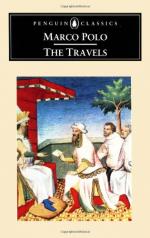The different provinces treated of in the chapters from lv. to lix. are strung by Marco upon an easterly, or, as we must interpret, north-easterly line of travel, real or hypothetical. Their names and intervals are as follows: (1) Bangala; whence 30 marches to (2) Caugigu; 25 marches to (3) Anin; 8 marches to (4) Toloman or Coloman; 12 days in Cuiju along a river to the city of (5) Fungul, Sinugul (or what not); 12 days further, on or along the same river, to (6) Ch’eng-tu fu. Total from Bangala to Ch’eng-tu fu 87 days.
I have said that the line of travel is real or hypothetical, for no doubt a large part of it was only founded on hearsay. We last left our traveller at Mien, or on the frontier of Yun-nan and Mien. Bangala is reached per sallum with no indication of interval, and its position is entirely misapprehended. Marco conceives of it, not as in India, but as being, like Mien, a province on the confines of India, as being under the same king as Mien, as lying to the south of that kingdom, and as being at the (south) western extremity of a great traverse line which runs (north) east into Kwei-chau and Sze-ch’wan. All these conditions point consistently to one locality; that, however, is not Bengal but Pegu. On the other hand, the circumstances of manners and products, so far as they go, do belong to Bengal. I conceive that Polo’s information regarding these was derived from persons who had really visited Bengal by sea, but that he had confounded what he so heard of the Delta of the Ganges with what he heard on the Yun-nan frontier of the Delta of the Irawadi. It is just the same kind of error that is made about those great Eastern Rivers by Fra Mauro in his Map. And possibly the name of Pegu (in Burmese Bagoh) may have contributed to his error, as well as the probable fact that the Kings of Burma did at this time claim to be Kings of Bengal, whilst they actually were Kings of Pegu.
Caugigu.—We have seen reason to agree with M. Pauthier that the description of this region points to Laos, though we cannot with him assign it to Kiang-mai. Even if it be identical with the Papesifu of the Chinese, we have seen that the centre of that state may be placed at Muang Yong not far from the Mekong; whilst I believe that the limits of Caugigu must be drawn much nearer the Chinese and Tungking territory, so as to embrace Kiang Hung, and probably the Papien River. (See note at p. 117.)
As regards the name, it is possible that it may represent some specific name of the Upper Laos territory. But I am inclined to believe that we are dealing with a case of erroneous geographical perspective like that of Bangala; and that whilst the circumstances belong to Upper Laos, the name, read as I read it, Caugigu (or Cavgigu), is no other than the Kafchikue of Rashiduddin, the name applied by him to Tungking, and




